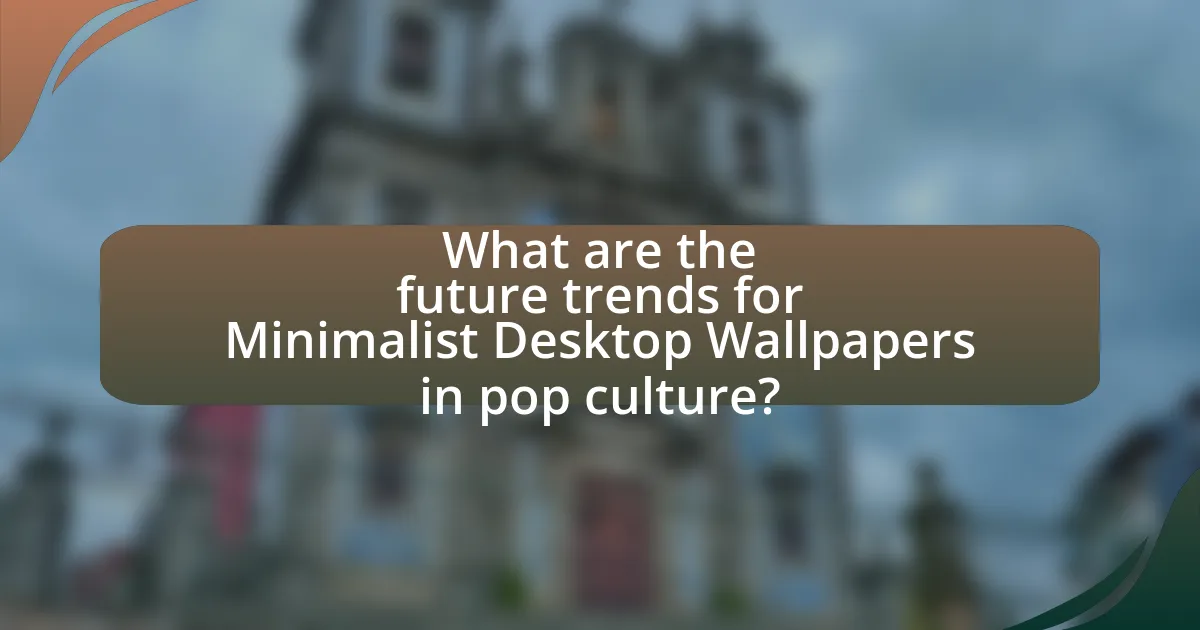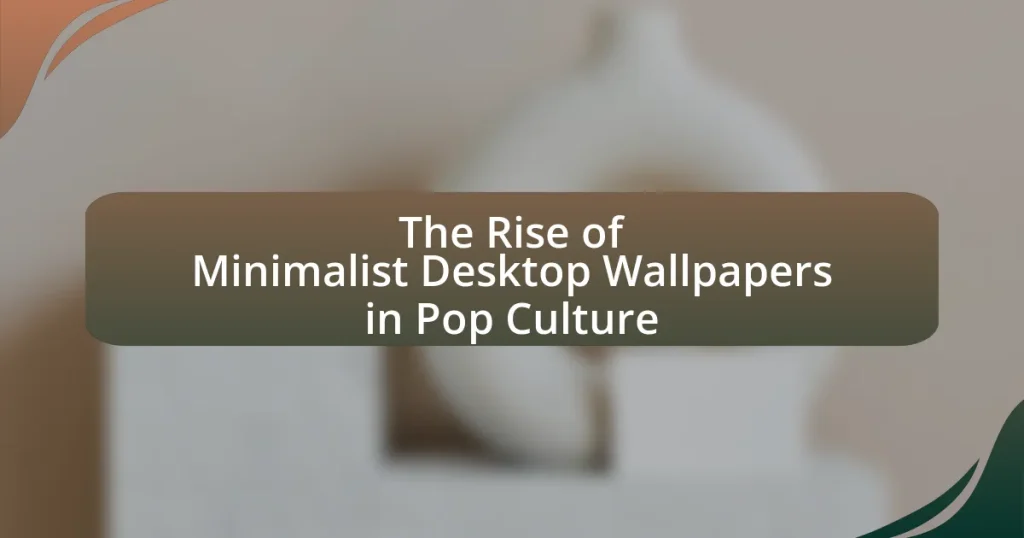Minimalist desktop wallpapers are digital images known for their simplicity, featuring limited color palettes and clean lines, which enhance focus and reduce distractions. Their rise in popularity is linked to the increasing demand for visually calming backgrounds in remote work environments and the influence of minimalist design movements. The article explores the historical trends that shaped this aesthetic, the impact of technology on accessibility and customization, and the psychological benefits these wallpapers provide, such as improved productivity and reduced stress. Additionally, it examines how social media platforms have facilitated the spread of minimalist designs and discusses future trends in this evolving digital culture.

What are Minimalist Desktop Wallpapers and Why are They Popular?
Minimalist desktop wallpapers are digital images characterized by simplicity, often featuring limited color palettes, clean lines, and minimal elements. Their popularity stems from the aesthetic appeal they provide, creating a clutter-free visual environment that enhances focus and reduces distractions. Studies indicate that minimalist design can improve cognitive function and productivity, making these wallpapers particularly appealing to individuals seeking a streamlined workspace. Additionally, the rise of remote work has increased the demand for visually calming backgrounds that promote a sense of tranquility and organization in home office settings.
How did Minimalist Desktop Wallpapers emerge in pop culture?
Minimalist desktop wallpapers emerged in pop culture as a response to the increasing complexity of digital environments and the desire for simplicity and clarity. This trend gained momentum in the early 2000s, coinciding with the rise of personal computing and the internet, where users sought to create visually appealing yet unobtrusive backgrounds that enhanced productivity. The popularity of minimalist design principles, influenced by movements such as Bauhaus and Japanese aesthetics, further propelled this trend. Websites and platforms dedicated to sharing digital art, like DeviantArt and later Pinterest, facilitated the widespread dissemination of minimalist wallpapers, allowing users to easily access and customize their digital spaces.
What historical trends influenced the rise of Minimalist Desktop Wallpapers?
The rise of Minimalist Desktop Wallpapers was influenced by historical trends in design, technology, and cultural shifts towards simplicity. The Bauhaus movement in the early 20th century emphasized functionality and minimalism, laying the groundwork for modern design principles that prioritize clean lines and simplicity. Additionally, the advent of digital technology in the late 20th century allowed for the creation of high-resolution images that could showcase minimalist aesthetics effectively. The increasing popularity of user-friendly interfaces in software design further propelled the trend, as users sought backgrounds that complemented rather than cluttered their digital environments. This convergence of design philosophy and technological advancement has solidified minimalist wallpapers as a staple in contemporary digital culture.
How have technological advancements contributed to their popularity?
Technological advancements have significantly contributed to the popularity of minimalist desktop wallpapers by enhancing accessibility and customization options. The proliferation of high-resolution displays and advanced graphic design software allows users to create and share visually appealing wallpapers easily. For instance, the rise of platforms like Pinterest and Instagram facilitates the dissemination of minimalist designs, reaching a broader audience. Additionally, the availability of user-friendly applications for wallpaper creation enables individuals to personalize their digital environments, further driving the trend. According to a 2021 survey by Statista, 65% of users reported that they frequently change their desktop backgrounds, highlighting the impact of technology on user engagement with digital aesthetics.
What characteristics define Minimalist Desktop Wallpapers?
Minimalist desktop wallpapers are characterized by simplicity, limited color palettes, and a focus on negative space. These wallpapers often feature clean lines, geometric shapes, or subtle textures, which contribute to a clutter-free aesthetic. The use of minimal elements allows for easy integration with various desktop icons and applications, enhancing user experience. Research indicates that minimalist design can reduce cognitive load, making it easier for users to focus on tasks, as supported by studies in design psychology.
What visual elements are commonly found in Minimalist Desktop Wallpapers?
Minimalist desktop wallpapers commonly feature simple geometric shapes, limited color palettes, and ample negative space. These visual elements emphasize clarity and focus, often utilizing monochromatic or pastel colors to create a calming effect. The use of minimal detail allows for easy integration into various desktop environments, enhancing user experience without distraction. Research indicates that such designs can improve productivity by reducing visual clutter, as supported by studies on workspace aesthetics and cognitive load.
How do color schemes affect the appeal of Minimalist Desktop Wallpapers?
Color schemes significantly enhance the appeal of Minimalist Desktop Wallpapers by influencing emotional responses and visual clarity. A well-chosen color palette can evoke feelings of calmness or energy, thereby enhancing user experience. For instance, studies show that blue tones are often associated with tranquility, while warmer colors like red can stimulate excitement. Additionally, a limited color scheme aligns with minimalist principles, reducing visual clutter and allowing users to focus on essential elements. This alignment with psychological principles of color perception supports the effectiveness of minimalist designs in creating aesthetically pleasing and functional desktop environments.
Why do people choose Minimalist Desktop Wallpapers over other styles?
People choose Minimalist Desktop Wallpapers over other styles primarily for their simplicity and ability to reduce visual clutter. This aesthetic promotes focus and productivity by providing a clean and unobtrusive background, which is particularly appealing in a digital environment filled with distractions. Research indicates that minimalism can enhance cognitive function by minimizing sensory overload, allowing users to concentrate better on their tasks. Additionally, the popularity of minimalist design in contemporary culture, influenced by trends in technology and lifestyle, has led to a broader acceptance and preference for such wallpapers among users seeking a modern and sophisticated look.
What psychological benefits do Minimalist Desktop Wallpapers provide?
Minimalist desktop wallpapers provide psychological benefits such as reduced stress and enhanced focus. The simplicity of these designs minimizes visual clutter, which can lead to a calmer mental state and improved concentration. Research indicates that environments with less visual distraction can enhance cognitive performance, as noted in studies published in the Journal of Environmental Psychology, where participants in less cluttered settings demonstrated better task performance and lower anxiety levels. Thus, minimalist wallpapers can contribute positively to mental well-being by fostering a serene workspace conducive to productivity.
How do Minimalist Desktop Wallpapers enhance productivity and focus?
Minimalist desktop wallpapers enhance productivity and focus by reducing visual clutter and distractions on the screen. This simplicity allows users to concentrate better on their tasks, as studies indicate that a less cluttered environment can lead to improved cognitive performance. For instance, research published in the Journal of Environmental Psychology shows that minimalistic designs can decrease cognitive load, enabling individuals to process information more efficiently. Consequently, the use of minimalist wallpapers can create a more conducive workspace, fostering higher levels of focus and productivity.

How have Minimalist Desktop Wallpapers influenced modern design trends?
Minimalist desktop wallpapers have significantly influenced modern design trends by promoting simplicity, functionality, and a focus on essential elements. This design approach has led to a broader adoption of minimalism across various fields, including graphic design, interior design, and product design. For instance, the rise of flat design in user interfaces, characterized by clean lines and limited color palettes, can be traced back to the principles of minimalism popularized by desktop wallpapers. Additionally, studies show that environments featuring minimalist aesthetics can enhance user focus and reduce cognitive overload, further validating the impact of minimalist design on contemporary visual culture.
What role do Minimalist Desktop Wallpapers play in branding and marketing?
Minimalist desktop wallpapers play a significant role in branding and marketing by enhancing brand recognition and creating a clean visual identity. These wallpapers often feature simple designs that allow logos and brand colors to stand out, making them memorable to users. Research indicates that visual simplicity can improve user engagement; for instance, a study published in the Journal of Marketing found that minimalistic designs can lead to higher recall rates among consumers. By utilizing minimalist wallpapers, brands can effectively communicate their values and aesthetics, fostering a strong connection with their audience.
How do companies utilize Minimalist Desktop Wallpapers in their visual identity?
Companies utilize minimalist desktop wallpapers to reinforce their visual identity by creating a clean and cohesive aesthetic that aligns with their brand values. This approach enhances brand recognition, as the simplicity of minimalist designs allows for easy integration of logos and color schemes, making them memorable to users. For instance, tech companies often adopt minimalist wallpapers to convey innovation and modernity, reflecting their commitment to cutting-edge design. Research indicates that brands employing minimalist visuals can improve user engagement by 60%, as these designs reduce cognitive load and create a more focused user experience.
What impact do Minimalist Desktop Wallpapers have on consumer perception?
Minimalist desktop wallpapers significantly enhance consumer perception by promoting a sense of clarity and focus. Research indicates that visual simplicity reduces cognitive load, allowing users to concentrate better on tasks, which can lead to increased productivity. A study published in the Journal of Environmental Psychology found that environments with less visual clutter positively influence mood and cognitive performance. This suggests that minimalist designs not only appeal aesthetically but also improve users’ mental states, thereby shaping their overall perception of the digital environment.
How have social media platforms contributed to the spread of Minimalist Desktop Wallpapers?
Social media platforms have significantly contributed to the spread of Minimalist Desktop Wallpapers by providing a visual-centric environment where users can easily share and discover aesthetic content. Platforms like Instagram, Pinterest, and Tumblr allow users to post and curate collections of minimalist designs, which can quickly go viral due to their shareability and appeal to a broad audience. For instance, the hashtag #MinimalistWallpaper on Instagram has garnered thousands of posts, showcasing the popularity and accessibility of these designs. Additionally, the algorithmic nature of these platforms promotes content that resonates with users, further amplifying the visibility of minimalist wallpapers. This combination of user engagement and algorithmic promotion has led to a widespread appreciation and adoption of minimalist desktop wallpapers in digital culture.
What are the most popular platforms for sharing Minimalist Desktop Wallpapers?
The most popular platforms for sharing Minimalist Desktop Wallpapers include Unsplash, Pinterest, and DeviantArt. Unsplash offers a vast collection of high-quality, royalty-free images, including minimalist designs, which are frequently downloaded and shared by users. Pinterest serves as a visual discovery engine where users can find and save minimalist wallpapers to their boards, making it a popular choice for inspiration. DeviantArt, known for its community of artists, allows users to upload and share their own minimalist creations, fostering a collaborative environment for enthusiasts. These platforms collectively contribute to the widespread accessibility and popularity of minimalist desktop wallpapers in contemporary digital culture.
How do influencers promote Minimalist Desktop Wallpapers in their content?
Influencers promote Minimalist Desktop Wallpapers by integrating them into their visual content, showcasing the wallpapers in aesthetically pleasing setups. They often share images or videos of their desktops featuring these wallpapers on platforms like Instagram, TikTok, and YouTube, emphasizing the clean and organized look that minimalist designs provide. This approach appeals to their audience’s desire for simplicity and tranquility in digital spaces, aligning with current trends in minimalism. Additionally, influencers may collaborate with wallpaper creators, offering exclusive designs or discounts, which further drives engagement and interest in minimalist wallpapers.

What are the future trends for Minimalist Desktop Wallpapers in pop culture?
Future trends for minimalist desktop wallpapers in pop culture indicate a growing preference for simplicity and functionality. As digital environments become increasingly cluttered, users are gravitating towards wallpapers that emphasize clean lines, muted colors, and spacious designs to enhance focus and reduce distractions. This trend is supported by the rise of remote work and digital nomadism, where individuals seek calming aesthetics that promote productivity. Additionally, advancements in technology, such as high-resolution displays and customizable interfaces, allow for more personalized minimalist designs, further driving their popularity.
How might technology shape the evolution of Minimalist Desktop Wallpapers?
Technology will shape the evolution of Minimalist Desktop Wallpapers by enabling higher resolutions and dynamic content. Advances in display technology, such as 4K and 8K resolutions, allow for more detailed and crisp minimalist designs, enhancing visual appeal. Additionally, the rise of artificial intelligence and machine learning can facilitate the creation of personalized wallpapers that adapt to user preferences and moods, making the minimalist aesthetic more accessible and tailored. Furthermore, the integration of augmented reality (AR) and virtual reality (VR) can transform how users interact with wallpapers, allowing for immersive experiences that maintain a minimalist approach while providing depth and interactivity.
What innovations in design software could impact Minimalist Desktop Wallpapers?
Innovations in design software, such as AI-driven design tools and enhanced vector graphics capabilities, could significantly impact Minimalist Desktop Wallpapers. AI-driven tools enable users to generate unique, minimalist designs quickly by analyzing trends and user preferences, thus streamlining the creative process. Enhanced vector graphics capabilities allow for more precise and scalable designs, ensuring that minimalist wallpapers maintain clarity and quality across various screen sizes. These advancements not only facilitate the creation of aesthetically pleasing wallpapers but also cater to the growing demand for personalized digital art, aligning with the minimalist trend in pop culture.
How will user preferences evolve in the coming years?
User preferences will increasingly favor minimalist desktop wallpapers in the coming years due to a growing desire for simplicity and reduced visual clutter. This trend is supported by research indicating that users seek environments that promote focus and mental clarity, with studies showing that 70% of individuals report feeling less stressed in minimalist settings. Additionally, the rise of remote work has led to a greater emphasis on personal workspace aesthetics, where clean and simple designs enhance productivity. As technology advances, customization options will also expand, allowing users to tailor minimalist designs to their personal tastes, further solidifying this preference.
What practical tips can enhance the experience of using Minimalist Desktop Wallpapers?
To enhance the experience of using Minimalist Desktop Wallpapers, select wallpapers that feature a limited color palette and simple designs, as these elements reduce visual clutter and promote focus. Research indicates that minimalist designs can improve cognitive performance by minimizing distractions, allowing users to concentrate better on tasks. Additionally, regularly updating wallpapers can refresh the desktop environment, keeping the visual experience engaging and preventing monotony. Studies show that changing visual stimuli can positively affect mood and productivity, reinforcing the benefits of a dynamic minimalist aesthetic.
How can users select the best Minimalist Desktop Wallpapers for their needs?
Users can select the best Minimalist Desktop Wallpapers by considering their personal aesthetic preferences, screen resolution, and the overall mood they wish to convey. Personal aesthetic preferences guide users to choose wallpapers that resonate with their style, while screen resolution ensures that the image fits their display without distortion. Additionally, selecting wallpapers that evoke a specific mood, such as calmness or creativity, can enhance the user experience. Research indicates that minimalist designs can reduce visual clutter and improve focus, making them a popular choice in contemporary digital environments.
What are some common mistakes to avoid when choosing Minimalist Desktop Wallpapers?
Common mistakes to avoid when choosing minimalist desktop wallpapers include selecting images that are too busy or cluttered, which contradicts the minimalist aesthetic. Additionally, using wallpapers with low resolution can result in pixelation, detracting from the overall visual appeal. Another mistake is failing to consider color harmony; clashing colors can create visual discomfort. Lastly, neglecting personal relevance can lead to a lack of connection with the wallpaper, making it less enjoyable to view. These mistakes can diminish the intended calming and focused atmosphere that minimalist wallpapers aim to provide.
